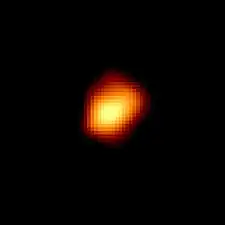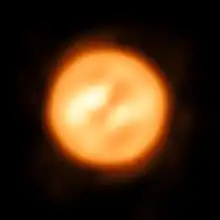List of stars with resolved images
The following is a list of stars with resolved images, that is, stars whose images have been resolved beyond a point source. Aside from the Sun, observed from Earth, stars are exceedingly small in apparent size, requiring the use of special high-resolution equipment and techniques to image. For example, Betelgeuse, the first star other than the Sun to be directly imaged, has an angular diameter of only 50 milliarcseconds (mas).[1]
List
| Star | Image | Diameter | Distance (ly) |
Imager | Notes | |
|---|---|---|---|---|---|---|
| Angular (mas) | Geometric (Sun = 1) | |||||
| The Sun |  |
1 930 000 | 1 | 0.000 015 8 (1 AU) |
Resolvable with the naked eye; see also solar telescope. |
Closest, brightest, and largest star by apparent diameter. |
| Proxima Centauri | 1.02 ± 0.08 | 0.141 ± 0.007 | 4.246 ± 0.006 | Very Large Telescope | 2nd closest star. | |
| Rigil Kentaurus (Alpha Centauri A) | 8.511 ± 0.020 | 1.224 ± 0.003 | 4.37 | Very Large Telescope - VINCI/VLTI[2] | ||
| Toliman (Alpha Centauri B) | 6.001 ± 0.034 | 0.863 ± 0.005 | ||||
| Altair | 3.2 | 1.66 ± 0.01 (polar) 2.02 ± 0.01 (equator) |
16.77 ± 0.08 | CHARA array - MIRC[3] | ||
| Rasalhague (Alpha Ophiuchi A) | 1.62 ± 0.03 | 2.39 ± 0.01 (polar) 2.87 ± 0.02 (equator) |
48.6 ± 0.8 | CHARA array - MIRC[4] | ||
| Alderamin (Alpha Cephei) | 1.35 ± 0.02 (polar) 1.75 ± 0.03 (equatorial) |
2.20 ± 0.04 (polar) 2.74 ± 0.04 (equator) |
48.8 ± 0.36 | CHARA array - MIRC[4] | ||
| Caph (Beta Cassiopeiae) | 1.70 ± 0.04 | 3.1 ± 0.1 (polar) 3.8 ± 0.1 (equator) |
54.7 ± 0.3 | CHARA array - MIRC[5] | ||
| Regulus (Alpha Leonis A) | 1.24 ± 0.02 | 3.2 ± 0.1 (polar) 4.2 ± 0.1 (equator) |
79.3 ± 0.7 | CHARA array - MIRC[5] | ||
| Algol Aa1 (Beta Persei Aa1) (stationary object) |
0.88 ± 0.05 | 4.13 | 93 ± 2 | CHARA array - MIRC[6] | ||
| Algol Aa2 (Beta Persei Aa2) (orbiting object) |
1.12 ± 0.07 | 3 | ||||
| Algol Ab (Beta Persei Ab) | 0.56 ± 0.10 | 0.9 | Observed radius of Algol Ab is an instrumental artifact, caused by bandwidth smearing. Actual radius is 1.73 ± 0.33 R☉. | |||
| Zeta Andromedae Aa | 2.502 ± 0.008 | 15.0 ± 0.8 (polar) | 189 ± 3 | CHARA array - MIRC[7][8] | First direct imaging of starspots on a star outside the Solar System. | |
| R Doradus |  |
57 ± 5 | 370 ± 50 | 204 ± 9 | New Technology Telescope[9] | 2nd largest known star by apparent diameter in Earth's sky, after the Sun. |
| Mira (Omicron Ceti) |  |
50 | up to 700 | 420 | Hubble - FOC[10] | |
| T Leporis |  |
5.8 15 for molecular layer |
100 | 500 | Very Large Telescope - VLTI[11]/AMBER[12] | |
| Pi1 Gruis |  |
18.37 | 694 | 530 | Very Large Telescope - PIONIER[13] | First directly observed granulation patterns on a star's surface outside the Solar System. |
| Antares |  |
41.3 ± 0.1 | 700 | 620 | Very Large Telescope - VLTI/AMBER[14] | |
| Betelgeuse |  |
50 | 630 | 643 ± 146 | ||
| Sheliak A (Beta Lyrae A) | 0.46 | 6 | 960 ± 50 | CHARA array - MIRC[18] | ||
| Theta1 Orionis C |  |
0.2 | 10.6 ± 1.5 | 1400 | Very Large Telescope - AMBER[19], GRAVITY[20] |
|
| Almaaz A (Epsilon Aurigae A) | 2.27 | 3.7 ± 0.7 | ca. 2000 | CHARA array - MIRC[21] | ||
| Almaaz B (Epsilon Aurigae B) | 5.9 ± 0.1 | |||||
See also
- Doppler imaging which produces maps of the surfaces of stars
- Zeeman–Doppler imaging which maps the magnetic fields of stars
- List of directly imaged exoplanets
References
- H.Uitenbroek; Dupree, A. K.; Gilliland, R. L. (1998). "Spatially Resolved Hubble Space Telescope Spectra of the Chromosphere of alpha Orionis". Astronomical Journal. 116 (5): 2501. Bibcode:1998AJ....116.2501U. doi:10.1086/300596.
- P. Kervella, F. Thevenin, D. Segransan, G. Berthomieu, B. Lopez, P. Morel, J. Provost, The diameters of Alpha Centauri A and B - A comparison of the asteroseismic and VINCI/VLTI views, Astronomy and Astrophysics 404 3 (2003) 1087–1097.
- J.D. Monnier; et al. (2007). "Imaging the Surface of Altair". Science. 317 (5836): 342–5. arXiv:0706.0867. Bibcode:2007Sci...317..342M. doi:10.1126/science.1143205. PMID 17540860.
- M. Zhao; et al. (2009). "Imaging And Modeling Rapidly Rotating Stars: Alpha Cephei And Alpha Ophiuchi". The Astrophysical Journal. 701 (1): 209–224. arXiv:0906.2241. Bibcode:2009ApJ...701..209Z. doi:10.1088/0004-637X/701/1/209.
- X. Che; et al. (2011). "Colder And Hotter: Interferometric Imaging Of Beta Cassiopeiae And ?lpha Leonis". The Astrophysical Journal. 732 (2): 68. arXiv:1105.0740. Bibcode:2011ApJ...732...68C. doi:10.1088/0004-637X/732/2/68.
- Baron, F.; Monnier, J.; Pedretti, E.; Zhao, M.; Schaefer, G.; Parks, R.; Che, X.; Thureau, N.; ten Brummelaar, T. A.; McAlister, H. A.; Ridgway, S. T.; Farrington, C.; Sturmann, J.; Sturmann, L.; Turner, N. (2012). "Imaging the Algol Triple System in the H Band with the CHARA Interferometer". The Astrophysical Journal. 752 (1): 20. arXiv:1205.0754. Bibcode:2012ApJ...752...20B. doi:10.1088/0004-637X/752/1/20.
- Kővári, Zs.; Bartus, J.; Strassmeier, K. G.; Oláh, K.; Weber, M.; Rice, J. B.; Washuettl, A. (2007). "Doppler imaging of stellar surface structure. XXIII. The ellipsoidal K giant binary ζ Andromedae". Astronomy and Astrophysics. 463 (3): 1071. arXiv:1301.0445. Bibcode:2007A&A...463.1071K. doi:10.1051/0004-6361:20065982.
- Roettenbacher, R.M.; Monnier, J.D.; Korhonen, H.; Aarnio, A.N.; Baron, F.; Che, X.; Harmon, R.O.; Kővári, Zs.; Kraus, S.; Schaefer, G.H.; Torres, G.; Zhao, M.; Ten Brummelaar, T.A.; Sturmann, J.; Sturmann, L. (2016). "No Sun-like dynamo on the active star ζ Andromedae from starspot asymmetry". Nature. 533 (7602): 217–220. arXiv:1709.10107. Bibcode:2016Natur.533..217R. doi:10.1038/nature17444. PMID 27144357.
- "The Biggest Star in the Sky". ESO. March 11, 1997. Retrieved 2010-06-26.
- "Hubble Separates Stars in the Mira Binary System". HubbleSite. 6 August 1997. Retrieved 26 June 2017.
- "Hundred metre virtual telescope captures unique detailed colour image". European Southern Observatory. 18 February 2009. Retrieved 26 June 2017.
- J.-B. Le Bouquin, S. Lacour, S. Renard, E. Thiébaut, A. Merand, T. Verhoelst, Pre-maximum spectro-imaging of the Mira star T Leporis with AMBER/VLTI, Astronomy and Astrophysics Volume 496, Number 1, March II 2009, L1-L4.
- "Giant Bubbles on Red Giant Star's Surface". www.eso.org. Retrieved 22 December 2017.
- "Astronomers Capture Best-Ever Image of Alien Star". Scientific American. 24 August 2017. Retrieved 27 August 2017.
- "Betelgeuse captured by ALMA". European Southern Observatory. 26 June 2017. Retrieved 26 June 2017.
- "Sharpest views of Betelgeuse reveal how supergiant stars lose mass". European Southern Observatory. 29 July 2009. Retrieved 26 June 2017.
- "The Flames of Betelgeuse". European Southern Observatory. 23 June 2011. Retrieved 26 June 2017.
- M. Zhao; et al. (2008). "First Resolved Images Of The Eclipsing And Interacting Binary Beta Lyrae". The Astrophysical Journal. 684 (2): L95–L98. arXiv:0808.0932. Bibcode:2008ApJ...684L..95Z. doi:10.1086/592146.
- "The orbit of Theta1 Orionis C". European Southern Observatory. 18 February 2009. Retrieved 26 June 2017.
- "GRAVITY discovers new double star in Orion Trapezium cluster". European Southern Observatory. 13 January 2016. Retrieved 26 June 2017.
- B. Kloppenborg; et al. (2010). "Infrared images of the transiting disk in the Epsilon Aurigae system". Nature. 464 (7290): 370–2. arXiv:1004.2464. Bibcode:2010Natur.464..870K. doi:10.1038/nature08968. PMID 20376144.
This article is issued from Wikipedia. The text is licensed under Creative Commons - Attribution - Sharealike. Additional terms may apply for the media files.